
TCO Audio Reviews: November 2023
 Wind in the Reeds. University of Florida Clarinet Ensemble, Mitchell Estrin, music director and conductor. G. Rossini: “Overture” to The Barber of Seville. P. Richards: A Butterfly Coughs in Africa. G. Holst: First Suite in E♭ for Military Band, op. 28/1. P. Grainger: Irish Tune from County Derry. G. Jacobs: Wind in the Reeds. M. Ravel: Pavane pour une infante defunte. B. Bartók: Romanian Folk Dances. G. Frescobaldi; Toccata. J.P. Sain: A Brief View of Eternity. G. Holst: “Jupiter, The Bringer of Jollity” from The Planets. J. P. Sousa: The Stars and Stripes Forever. Mark Masters Records, CDZ6729. Total Time: 72:04.
Wind in the Reeds. University of Florida Clarinet Ensemble, Mitchell Estrin, music director and conductor. G. Rossini: “Overture” to The Barber of Seville. P. Richards: A Butterfly Coughs in Africa. G. Holst: First Suite in E♭ for Military Band, op. 28/1. P. Grainger: Irish Tune from County Derry. G. Jacobs: Wind in the Reeds. M. Ravel: Pavane pour une infante defunte. B. Bartók: Romanian Folk Dances. G. Frescobaldi; Toccata. J.P. Sain: A Brief View of Eternity. G. Holst: “Jupiter, The Bringer of Jollity” from The Planets. J. P. Sousa: The Stars and Stripes Forever. Mark Masters Records, CDZ6729. Total Time: 72:04.
This album is an excellent example of fine clarinet choir playing and the repertoire represents seminal transcriptions as well as original works for clarinet choir. The ensemble sounds mature and polished, the variety and breadth of the repertoire is impressive.
While every work on the album is memorable, Gordon Jacob’s Wind in the Reeds really puts the ensemble skills and musicianship of the group on full display. The blend and consistency in the ensemble, from top to bottom is outstanding. It’s not often that such thoughtful care is put into this genre and the value of this album as a reference recording for all clarinet choirs is undeniable.
The Frescobaldi Toccata is another gem on this recording. Although it was arguably not composed by Frescobaldi himself, this transcription highlights the flexibility of this clarinet choir and shows off the organ-like quality of the ensemble sound. The wide variety of tone colors and styles here show the quality of the group and conductor Mitchell Estrin. The level of artistry achieved here is worthy of a listen by all serious clarinet students.
The perfect ending to such a wonderfully complete album is Sousa’s Stars and Stripes Forever, which is a virtuosic showpiece when played by this clarinet choir, complete with piccolo clarinet solo. This transcription is delightful and played quite well by the University of Florida Clarinet Ensemble.
This album is terrific from start to finish and the quality of the playing, variety of the repertoire, and the thoughtful interpretations make this a valuable reference recording for students and teachers of the clarinet alike.
– Spencer Prewitt
 Flights of Imagination. Arcadian Winds: Vanessa Holroyd, flute; Jane Harrison, oboe; Mark Miller, clarinet; Laura Carter, horn; Janet Underhill, bassoon; Sirius Quartet: Fung Chern Hwei, violin; Gregor Huebner, violin; Sunjay Jayaram, viola; Jeremy Harman, cello; Slovak Radio Symphony Orchestra, František Dyk; Seattle Symphony Orchestra, Gerard Schwarz; Concordia Orchestra, Marin Alsop; D. Burwasser: Catching Fireflies, Whirlwind, Flux, A Well-Traveled Road, Puck’s Game. Navona, NV6512. Total Time: 43:41.
Flights of Imagination. Arcadian Winds: Vanessa Holroyd, flute; Jane Harrison, oboe; Mark Miller, clarinet; Laura Carter, horn; Janet Underhill, bassoon; Sirius Quartet: Fung Chern Hwei, violin; Gregor Huebner, violin; Sunjay Jayaram, viola; Jeremy Harman, cello; Slovak Radio Symphony Orchestra, František Dyk; Seattle Symphony Orchestra, Gerard Schwarz; Concordia Orchestra, Marin Alsop; D. Burwasser: Catching Fireflies, Whirlwind, Flux, A Well-Traveled Road, Puck’s Game. Navona, NV6512. Total Time: 43:41.
Daniel Burwasser (b. 1960) is an American composer, percussionist, and teacher. Flights of Imagination (released in April of 2023) is his first solo album, and it features some significant clarinet playing. The two compositions that feature clarinet most prominently are Catching Fireflies and Whirlwind. This review will focus on those tracks.
Catching Fireflies is performed by the Seattle Symphony, and within the first minute listeners can hear the importance of clarinet within Burwasser’s compositional style. Interruptive, jarring clarinet playing can be heard rising from the orchestra immediately morphing into something more lyrical and song-like before falling back into the texture of the group. Providing the driving rhythmic motion, the clarinet section in this work is ever-present. As the work proceeds the listener can hear how important the clarinet is in Burwasser’s work as it consistently uses the clarinet to cycle all themes through its part.
Whirlwind is a three-movement work for woodwind quintet featuring Mark Miller on clarinet. Immediately through the thick texture of the first movement, we can clearly hear the melodic clarinet voice shining. Miller’s tone and power are an excellent way to feature Burwasser’s style of composition which seems based in those very attributes. Miller’s ability to cut through the texture of the other more loud and penetrating instruments showcases his command of the instrument. Movement two begins with double reeds Jane Harrison and Janet Underhill immediately accompanied by Miller in the low register creating a sense of calm with longer and more mellow sotto voce style playing proving his dexterity. Shortly after we are treated to a full expression of Miller’s lyrical playing, which is beautiful and lush showcasing his shimmering tone as the clarinet shines through the characteristically thick texture created by Burwasser. Movement three features the clarinet most prominently in the context of a modern take on a fugue. Here Miller shows us a more playful and bouncy side of Burwasser’s music, alive with excellent character playing throughout all parts. His command of articulation, style, and specifically staccato are prominent throughout the movement.
This album is an excellent showcase of the composer’s depth and breadth of style as well as an illustration of what the clarinet is capable of. This is a wonderful album of works by this composer, worthy of the library of any 20th century music lover.
– Vanessa Davis
 Pinnacle Vol 3. Karel Dohnal, clarinet; Martin Kasík, piano; Jan Souček, oboe; Dieter Flury, flute; Lukáš Polák, cello. Jakub Černohorsky, violin; Tomáš Svozil, cello; Alexandr Stary, piano; Brenda Quartet: Jakub Černohorský, violin; Ondřej Pustějovský, violin; Petr Benda, viola; Tomáš Svozil, cello; Juventas New Music Ensemble, Oliver Caplan. D. Bavdek: Capriccetto; String Quartet No. 1. A. E. Cohen: Watercolors of the Master Who is Accustomed to Paint Oils. R. Brown: Trio for Violin, Horn, and Piano. A. Schneider: Les Exubérants, op.11 ; Les Enchanteresses Dansantes, op. 12. Navona, NV6508. Total Time: 42:47.
Pinnacle Vol 3. Karel Dohnal, clarinet; Martin Kasík, piano; Jan Souček, oboe; Dieter Flury, flute; Lukáš Polák, cello. Jakub Černohorsky, violin; Tomáš Svozil, cello; Alexandr Stary, piano; Brenda Quartet: Jakub Černohorský, violin; Ondřej Pustějovský, violin; Petr Benda, viola; Tomáš Svozil, cello; Juventas New Music Ensemble, Oliver Caplan. D. Bavdek: Capriccetto; String Quartet No. 1. A. E. Cohen: Watercolors of the Master Who is Accustomed to Paint Oils. R. Brown: Trio for Violin, Horn, and Piano. A. Schneider: Les Exubérants, op.11 ; Les Enchanteresses Dansantes, op. 12. Navona, NV6508. Total Time: 42:47.
Pinnacle, Vol. 3, is a stimulating collection of contemporary chamber music for strings, piano, and winds by composers Alla Elana Cohen, Andrew Schneider, Dušan Bavdek, and Richard E. Brown. Several tracks on the album feature clarinetist Karel Dohnal including, Watercolors of the Master Who is Accustomed to Paint Oils, Les Exubérants, op. 11, and Les Enchanteresses Dansantes, op. 12.
Watercolors of the Master Who is Accustomed to Paint Oils Vol. 1, series 9, is a four-movement work for clarinet and piano, beautifully performed by clarinetist Karel Dohnal and pianist Martin Kasik. While the movements or miniatures are relatively short, they are full of character, sentiment, and zeal. The first movement begins with the clarinet alone before the piano enters with a melodic gesture that echoes the haunting clarinet line. Wistful piano chords alternating with lyrical melodic lines in the clarinet create an emotive second movement. The third movement is punctuated by spirited staccato figures in the piano and clarinet that erupt into a wave of virtuosity to close the movement. The final movement is more severe and dramatic in nature, featuring intense melodic lines that ascend to sustained notes in the upper register of the clarinet.
The final two tracks on the album, Les Exubérants, op. 11 and Les Enchantereses Dansantes, op. 12, were written by composer Andrew Schneider. Les Exubérants, op. 11 is a cheerful duo for clarinet and oboe. Expertly performed by Dohnal and oboist Jan Souček, this work is a virtuosic showcase for the two wind instruments. Throughout the piece, the melodic lines between the two instruments interweave in playful banter, creating a stimulating musical conversation for the listener. Les Enchantereses Dansantes, op. 12 for flute, clarinet, and piano, is an animated trio that features several different dance forms including a waltz, tango, habanera, and samba. This album is a wonderful collection of contemporary chamber music highlighting magnificent performances by clarinetist Karel Dohnal and their collaborators.
– Kylie Stultz-Dessent
 Christmas Clarinets. University of Florida Clarinet Ensemble; Mitchell Estrin, conductor; Juan Rojas, String Bass; Dolly Roberts, Harp; Scott Wilson, Trumpet; Jonathan Haas, Timpani; Chip Birkner, Percussion; Mary McLean, Percussion; Joshua Mazur, Organ; Peter Ilyich Tchaikovsky, composer. Mark Records. Total Time: 51:00.
Christmas Clarinets. University of Florida Clarinet Ensemble; Mitchell Estrin, conductor; Juan Rojas, String Bass; Dolly Roberts, Harp; Scott Wilson, Trumpet; Jonathan Haas, Timpani; Chip Birkner, Percussion; Mary McLean, Percussion; Joshua Mazur, Organ; Peter Ilyich Tchaikovsky, composer. Mark Records. Total Time: 51:00.
Christmas Clarinets showcases the University of Florida Clarinet Ensemble, led by Dr. Mitchell Estrin. This ensemble has delivered remarkable performances across the United States and Europe since its establishment in 1999. They have graced the Vandoren Clarinet Ensemble Festival in various cities, including Los Angeles, Washington D.C., Chicago, Seattle, Atlanta, East Lansing, Champaign-Urbana, Mobile, Greensboro, and Rochester. Additionally, they have presented feature recitals at the International Clarinet Association ClarinetFest® in Kansas City, Washington D.C., and Atlanta.
The album Christmas Clarinets comprises clarinet ensemble renditions of cherished Christmas classics such as Sleigh Ride, Herz und Mund und Tat und Leben, BWV 147, Dances from the Nutcracker, Suite of Carols, The Sussex Mummers, Christmas Carol, and Who Can Retell?
The opening track, Sleigh Ride, arranged by T. Miller, stands out as a personal favorite, filled with delightful surprises. I won’t divulge them here, but it’s an attention-grabbing start. The subsequent track, Herz und Mund und Tat und Leben, BWV 147, provides a soothing contrast to the exuberant Sleigh Ride.
Dances from the Nutcracker exhibits superb balance, remarkable expressiveness, precision in articulation, and outstanding ensemble performance. Particularly noteworthy is the “Danse Chinoise,” characterized by the robust, steady presence of the low clarinet at the outset, which is consistently engaging in harmonious interplay with the mid-range clarinets. The same can be said for “Danse Russe,” which is equally enjoyable.
The album then transitions into Suite of Carols, incorporating percussion instruments. The tempi are flawlessly executed, with special commendation to the low clarinets, which shine in this performance. The Sussex Mummers’ Christmas Carol, arranged by Matthew Johnston, is a beautifully rendered piece that serves as a captivating departure from the percussive Suite of Carols. Johnston’s arrangement brilliantly showcases the expressive potential of the clarinet family in this chorale-like composition.
This recording embodies precision, musicality, and meticulous attention to detail. The clarity in the balance between the various voices reflects Dr. Estrin’s expertise, both as an ensemble director and a musician. He skillfully assembles these elements to inspire the ensemble members not only to collaborate harmoniously, as they have done beautifully in this recording but also to listen to each other attentively, as evidenced in their performance.
These qualities, along with Estrin’s deep understanding of recording for this musical ensemble, shine throughout this project. If you seek a reference for exemplary clarinet ensemble recordings, especially in the spirit of Christmas, Christmas Clarinets is a must-listen.
– Kristine Dizon
Comments are closed.